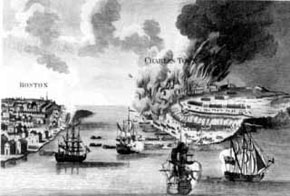 |
Civil War Battles |
|
State War Records |
| AL - AK - AZ - AR - CA - CO - CT - DE - FL - GA - HI - ID - IL - IN - IA - KS - KY - LA - MA - MD - ME - MI - MN - MS - MO - MT - NE - NV - NH - NJ - NM - NY - NC - ND - OH - OK - OR - PA - RI - SC - SD - TN - TX - UT - VT - VA - WA - WV - WI - WY |
The Battle of Fort Sumter/Charleston
August 17-23, 1863 in Charleston, South Carolina
 |
|||||||||||||||||||||
|
Shortly after the July 18 attack on Fort Wagner, Gen. Quincy Gillmore of the Union army came up with a bold plan. He ordered Col. Serrell to build a 24,000 lb. battery gun capable of hitting Fort Sumter and Charleston fro Morris Island. Serrell at first studied the plan and said it couldn't be done.After being persuaded and a promise of anything he needed to get the job done, he bgan the strenious task.
The battery was to be built in the marsh area between James and Morris Islands. Work began on August 10th. While working on the battery, Confederates would fire on them with their batteries. To confuse the Confederates, Serrell had a fake battery being built on the southern end of the island. By August 17, the battery was ready for armament. The battery's garrison was a detachment of the 11th Maine Infantry under Lt. Charles Sellmer. On August 21, Sellmer and his men took charge of the new battery, which was now referred to as the "Swamp Angel".
By existing rules of warfare, Charleston was a legitimate target. It was an armed camp. There were fortifications in the city. It was home to a number of munition plants, and its wharves served blockade runners who carried war supplies. But the reasons ran even deeper. To Northerners, Charleston was the symbol of rebellion. It was there that South Carolina officials voted for secession and started the inevitable march toward war. The firing on Fort Sumter, which started the conflict, only increased the North's belief that Charleston was a city of fire-eaters who deserved punishment. For most Northerners, Charleston's destruction seemed just retribution. The Northern military also wanted redemption. Their impotence during the 1861 Fort Sumter crisis had deeply wounded the pride of many officers. If they could reduce Charleston like the Romans had reduced Carthage, so much the better.
During the construction of the battery, Gillmore and his men were firing on Fort Sumter. On Aug 21, Gillmore received word that the "Swamp Angel" was ready to commence firing.
Gillmore sent a message by way of Wagner to Charleston, demanding that Gen. P.G.T. Beauregard immediately evacuate Morris Island and Fort Sumter or Charleston would be fired upon. The note reached Confederate headquarters at 10:45 P.M. Beauregard was not present and since the message was unsigned, it was returned for verification.
At 1:30 A.M., August 22, Lieutenant Charles Sellmer, aiming his gun by the compass reading taken on St. Michael's steeple, fired the first round into the city. Before dawn, the Swamp Angel would send sixteen shells into Charleston. The resulting flames were clearly seen by both Confederates and the Federals.
The next morning at 9 A.M., Gillmore's note, now signed, again reached General Beauregard's headquarters. This time the general was present and an enraged Beauregard sent an immediate reply. The Confederate general considered the firing on the city an act of desperation and barbarity. He asked to be given time to evacuate Charleston and Fort Sumter. The Confederate commander finished by indicating that unless he were given time to evacuate the city's noncombatants, he would use the "strongest means of retaliation. . . ." The request for time was denied.
Beauregard's demand to allow citizens to leave was backed up by similar requests from foreign consuls. In his answer to Beauregard, Gillmore gave the Confederates one day to clear the city. At the same time, the Federal commander took the opportunity to lecture the Confederates on Charleston's role as an armed camp and munition site, pointing out that it was a legitimate military target and, since the campaign had been going on for forty days, the civilians and military should have known that a bombardment was inevitable.
Throughout the next night of the 22nd, the Swamp Angel remained silent. The next night, firing resumed on the city and Fort Sumter.
Despite a severe pounding, Fort Sumter's garrison held out. Siege operations continued against Fort Wagner on Morris Island.
